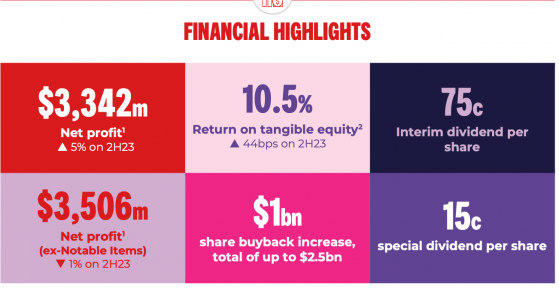Street Calls of the Week
Westpac Banking (ASX:WBC) Corporation Ltd has announced a 16% decline in its first-half profit but offset investor concerns with significant capital returns.
The Australian banking giant declared a special dividend of 15 cents per share and an interim dividend of 75 cents per share, a 7% increase from the previous year. Furthermore, the bank expanded its buyback program from $1.5 billion to $2.5 billion.
These financial moves are supported by a robust balance sheet and business momentum, according to CEO Peter King.
Cautionary economic outlook
Despite these positive returns to shareholders, King expressed caution regarding the economic outlook. He suggested that interest rates might not be reduced until 2025, contrary to his economics team's prediction of a cut in the fourth quarter of the current year.
“Our economics team is forecasting a cut in the fourth quarter. My personal view is that’s a bit too early. I think the economy is going well at a macro level and there’s certainly demand for infrastructure, housing, energy transition, so I think that’s a bit early.
“Whether or not we need a rate increase, I’m not sure... we can see some slowdown in spending in the economy, we can see the impact on employment but probably not enough, we need a further slowdown there,” he said.
The bank has observed increased stress in its loan portfolios, with 18,000 hardship packages currently active, up from 11,000 pre-pandemic.
Growth in major segments
The bank's consumer banking sector faced a substantial profit decrease of 32% to $1 billion, mainly due to competitive pricing in home loans.
Despite the competitive environment, Westpac managed to grow its major Australian segments, with increases in mortgages, deposits and business lending. The net interest margin dropped slightly by 7 basis points to 1.89% and core NIM fell by 9 basis points to 1.8%.
“Westpac’s balance sheet is in good shape and with the momentum in our business, supports a special dividend of 15c per share fully franked and an increase in the buyback program of $1 billion to $2.5 billion,” King told shareholders.
“This half, we’ve managed growth and margins in a disciplined way amid a slowing economy and competitive banking sector.
“We grew our major Australian segments in a disciplined way with mortgages and deposits up 5% and business lending up 9% over the year. The impact of competition on mortgage margins moderated this half.”
Overall, Westpac's $3.34 billion net profit aligns with analyst expectations and the bank remains optimistic about its future performance despite economic uncertainties and competitive challenges in the banking sector.
